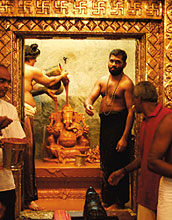|
 The time is 4 pm on a Thursday. The place is Puduraya in Kuala Lumpur, a busy transnational bus depot in Malaysia. Things are more than just chaotic—hordes of tourists and travellers are rushing about to catch buses in different directions. The streets are chock-a-block with pedestrians, and vendor stalls. The hustle and bustle is at a peak. The time is 4 pm on a Thursday. The place is Puduraya in Kuala Lumpur, a busy transnational bus depot in Malaysia. Things are more than just chaotic—hordes of tourists and travellers are rushing about to catch buses in different directions. The streets are chock-a-block with pedestrians, and vendor stalls. The hustle and bustle is at a peak.
Diagonally opposite the Puduraya bus stand lies an ocean of stillness and tranquility. It is time for prayer and Aarti (act of burning camphor and singing hymns in praise of God) at Lord Ganesha temple. People from all walks of life and ethnicities—Hindus, Chinese, Sikhs and others—are here to ask the divine for fulfillment of their wishes. The temple is known for its divine powers.
As per Vaastu science the temple built upon 3 sloping corners is a source of divine power where cosmic energy flows naturally. It is the only temple noticed in the world where shankh pooja (conch shell with holy sacred water) is performed. It is spectacular to see the glittering black statue of Lord Ganesha taking a bath of water, honey, curd, sandal and milk. Looking at one of the bells that has 1913 carved over it, one can presume the year it came into existence. But its history, according to a narrator, dates back to 1897.
An Indian gardener employed at the residence of a British police officer named Wagner Durai discovered this statue placed under a peepal tree. Indentured workers brought to Malaysia from India by the British placed the statue. The gardener started performing rituals and built a small shrine with hanging bells. Its vibrations started drawing the attention of people around and the sound of the bell annoyed Wagner and he ordered to remove statue from there. And next day he had a paralytic stroke. All tried and tested methods of treatment failed to revitalize his paralyzed body. One day, crouched in front of the statue he surrendered and prayed for his recovery. At that point the gardener applied the aarti ash and it resulted in a miraculous recovery of the officer. Then he donated the land and a certain amount of money to construct a temple. Ever since, the numbers of devotees have been growing.
Some years ago the High court building was located at Puduraya. Lawyers taking up fresh briefs, judge about to announce verdicts, petitioners who had lost hope, prayed here before proceeding to the court premises. There are many such stories of prayers being answered and people donating bounty as offering to God. Today the High Court building is no longer here, but lawyers still do come and pray. Majority of donations come from the lawyers.
People have witnessed miracles happening and there are many such stories to prove the authenticity of such acts. Daily they make the place vibrant with mantras and yagyas. In Hindu philosophy mantra is a medium to please gods and for evoking powers. At one end of the spectrum it is believed that chanting of a Mantra is a form of prayer that Hindus believe Gods listen to. On other end of spectrum it is a belief that Prayer is a universal philosophy. It doesn’t matter how you pray but what matters is that you pray.
Indulge yourself in vibrations of temple and feel the power. Close your eyes and look into your heart and pray. Your prayer will go up and answers will come down. Arrival of people from all religions, and multi ethnic backgrounds, proves a point that God listens to the devotion with which you have offered prayer. With all reverence when you surrender in front of the statue, supreme power gets evoked in stone and you are connected. When you still yourself and calm down you already have started the process of connecting to cosmic powers. Once you feel the union happening you have started awakening God within.
|